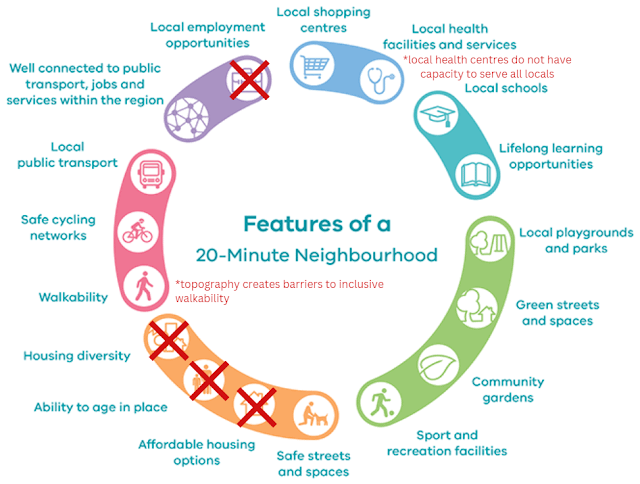Case Study: New Westminster as a 15 Minute City
Recently, a group of teens approached New West City Council with a 15 Minute City proposal. Their proposal was also released publicly a few months ago, but did not draw as much attention as the recent news article: you can read it here.
This article is misleading in focusing primarily on the emissions impact this would generate by reducing traffic in the immediate area, and beyond that, offers very little information regarding the best-practices of a 15 Minute City in regards to infrastructure and built-environment.
Reddit's local group immediately jumped on this, celebrating this plan as immediately do-able, and with no down sides. They also highlighted how wonderful this plan would be for the disabled and elderly. When it was pointed out that opportunities for further accessibility are abundant, but as it is currently, New West does not meet many of the 15 minute city criteria, people lost their minds against those "able-ist naysayers." So, let's break down how New West would stack up as a 15 minute city as-is, according to best practices.
If we remove everything that would require New West to undergo huge changes in zoning and development to be feasible, this model looks more like this:
Now, let's map it, starting with Downtown.
And next, let's talk about super blocks:
Super blocks are an element of most (if not all) currently documented 15 Minute Cities. They create spaces safe from traffic, as well as further opportunities for green space and community by utilizing planters, tables, benches, etc. Super blocks are also the reason 15 Minute Cities are able to promote themselves on the theory of lowering emissions. Developing them in New West, however, presents a unique set of challenges...
This is because of New West's transit infrastructure, and also because New West does not have separation between residential and commercial properties. So, if we apply super blocks linearly-vertically, we prevent access to current bus routes. However, if we apply superblocks linearly-horizontally, we block residents from accessing their parking lots, as well as diverting already over-capacity commuter and commercial traffic to a different already-congested artery. If we're being honest, super blocks are unlikely to be feasible in New West.
But for the sake of the accessibility argument, let's pretend they were. THIS IS GONNA BE SO AMAZE-BALLS FOR ACCESSIBILITY!!! I can hear you screaming it from the rooftops already - A community where you can walk everywhere HAS to be more accessible than one that requires driving, right? In the right set of circumstances it could be.
However, even if we were able to limit traffic in this neighborhood, we have to accept the reality that this entire 15 Minute area is on a steep slope, and almost all of the necessary elements mapped above lie at the bottom of it, where the lowest amount of housing is. This would potentially isolate a plethora of people, including those with lung or cardiac concerns, those with mobility challenges, those with vestibular challenges that limit their ability to navigate even minor changes in altitude, those who struggle with gross motor skills (like balance), and those who cannot regulate temperature (during high outside temps and / or cardio activity) due to medication side effects.
This means that to ensure services are truly accessible, you would need to have each of them placed along every vertical block. (Which to be fair, can be seen in some existing models, and is possible with attentive planning.)
Revisting the above, we need to reiterate that if Super Blocks were applied linearly-vertically, we'd also be potentially preventing these same disabled individuals from accessing public transit.
If Super Blocks were applied horizontally, causing the diversion of commuter and commercial traffic, we'd be seriously disrupting emergency vehicle routes to the nearest hospital. In this scenario, emissions would also rise due to the increase in traffic congestion.
As you can see, the 6th and 6th area of New West does not fare well either by this model, as it still lacks greatly in terms of necessary amenities. You may also have noticed that this area is entirely free of affordable housing developments. I think this time, we'll be able to get an idea of the true breadth of these issues best through the comparison of the 15 Minute Cities below, and the 6th and 6th map we've already seen above. (And yes, the areas of all 5 maps are comparable, I verified it.)
In conclusion, while it could be valuable for New West to take this model into consideration throughout future development, by creating more medical, grocery and education spaces in more varying areas, and expanding their transit accessibility into more residential neighborhoods, New West as it is currently cannot fit a best practices 15 Minute City model. It simply does not contain the resources, or infrastructure to support all community members in a safe and inclusive way.
